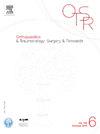Acetabular revision for iliopsoas impingement: a study of 55 cases at 3 years of follow-up. Does the procedure achieve the Minimal Clinically Important Difference (MCID) in the Oxford-12 score in more than 80% of cases?
IF 2.3
3区 医学
Q2 ORTHOPEDICS
引用次数: 0
Abstract
Introduction
Several surgical options can be offered to manage iliopsoas impingement. Research published on cup replacements often concerns a small population size or multicentre studies, suggesting a variety of indications. We conducted a retrospective single centre study screening according to a specific protocol of a population of patients who had a cup replacement for iliopsoas impingement. The objectives were: 1) to specify the functional outcomes and the achievement of the Minimal Clinically Important Difference (MCID) and the Patient Acceptable Symptom State (PASS) according to the Oxford-12 score, and 2) to assess the complication rate.
Hypothesis
Our hypothesis was that acetabular replacements achieve a Minimal Clinically Important Difference (MCID) in more than 80% of cases.
Patients and methods
Fifty-five hips underwent acetabular revision between 2011 and 2020. Forty-three were performed as first-line surgery, eight after failed tenotomy and four after failed anterior hip capsule thickening plasty. A CT scan of all the hips revealed a median overhang of 9 mm (7; 12) and a 7 ° cup anteversion (2; 19). Follow-up included assessment of the Oxford-12 score using MCID and PASS, the Merle d'Aubigné score, an assessment of hip flexion muscle strength using the Medical Research Council scale, and an assessment of satisfaction and complications.
Results
At a mean follow-up of 3 years (2–10), the difference in the Oxford score before and at follow-up was 18 points (15; 27) (p < 0.001), the median Medical Research Council score was 4.5 (4; 5) and patients were satisfied or very satisfied in 73% of cases (40/55). The MCID was achieved for 87% of the hips (48/55), and the PASS was achieved in 67% of cases (33/55). The rate of complications involving surgical revision was 10.9% (6/55) with respectively: two anterior dislocations, one early infection on day 10 resolved after wound irrigation and appropriate antibiotic therapy, one intraoperative fracture of the trochanter requiring osteosynthesis and one arthroscopic revision to remove a free cement fragment.
Conclusion
Due to a good functional outcome but a high complication rate, a cup replacement can be offered for iliopsoas impingement associated with acetabular malposition or significant overhang.
Level of evidence
IV.
髋臼翻修术治疗髂腰肌撞击:对 55 例病例进行 3 年随访的研究。在超过 80% 的病例中,该手术是否达到了 Oxford-12 评分的最小临床意义差异 (MCID)?
导言:治疗髂腰肌撞击症有多种手术方案可供选择。已发表的有关髋臼杯置换术的研究通常涉及小规模人群或多中心研究,并提出了多种适应症。我们进行了一项回顾性单中心研究,按照特定方案对因髂腰肌撞击而接受髋臼杯置换术的患者进行筛选。研究的目的是1)根据牛津-12评分,明确功能结果以及最小临床意义差异(MCID)和患者可接受症状状态(PASS)的实现情况;2)评估并发症发生率:我们的假设是,80%以上的髋臼置换术能达到最小临床重要差异(MCID):2011年至2020年间,55例髋关节接受了髋臼翻修术。其中43例为一线手术,8例为腱切开术失败后的手术,4例为髋关节前囊增厚成形术失败后的手术。所有髋关节的CT扫描显示,中位悬伸为9毫米(7;12),髋臼杯反转为7°(2;19)。随访包括使用 MCID 和 PASS 评估牛津-12 评分、Merle d'Aubigné 评分、使用医学研究委员会量表评估髋关节屈曲肌力,以及满意度和并发症评估:平均随访 3 年(2-10 年),随访前和随访时的牛津评分相差 18 分(15; 27)(P 结论:牛津评分在随访前和随访时相差 18 分(15; 27):由于髋臼位置不正或明显悬垂导致的髂腰椎撞击症具有良好的功能效果,但并发症发生率较高,因此可以采用髋臼杯置换术:证据等级:IV。
本文章由计算机程序翻译,如有差异,请以英文原文为准。
求助全文
约1分钟内获得全文
求助全文
来源期刊
CiteScore
5.10
自引率
26.10%
发文量
329
审稿时长
12.5 weeks
期刊介绍:
Orthopaedics & Traumatology: Surgery & Research (OTSR) publishes original scientific work in English related to all domains of orthopaedics. Original articles, Reviews, Technical notes and Concise follow-up of a former OTSR study are published in English in electronic form only and indexed in the main international databases.

 求助内容:
求助内容: 应助结果提醒方式:
应助结果提醒方式:


